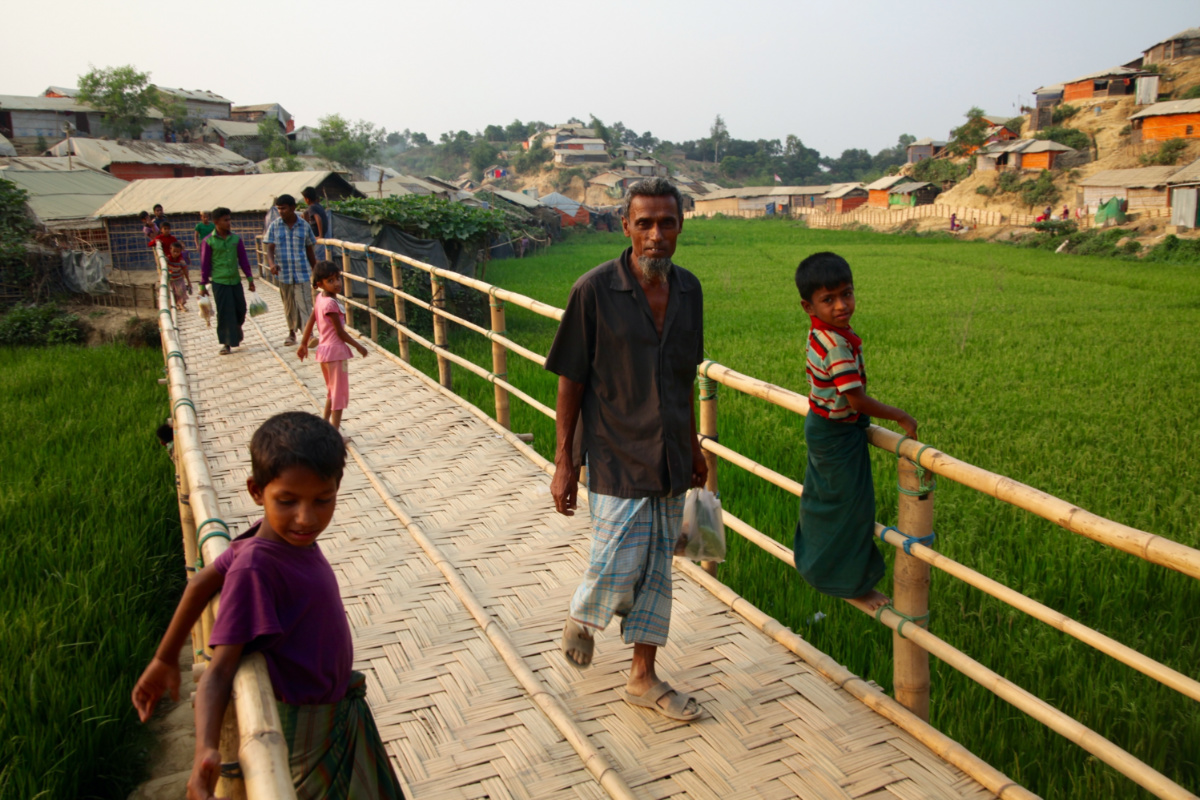Chennai, India
Thomson Reuters Foundation
Military and civil conflicts could intensify along the Bay of Bengal coastline, fuelled by climate change-linked migration, land loss and displacement, researchers say.
The area is seeing frequent extreme weather, which combined with its strategic, social and economic fault-lines, makes it “fertile ground” for social friction and violence, they warned.

Rohingya refugees on a bridge over a rice paddy in Chakmarkul refugee camp in Bangladesh on 4th April, 2018. PICTURE: Thomson Reuters Foundation/Jared Ferrie.
A report, released by thinktanks the Netherlands-based Clingendael Institute and India’s Institute of Peace and Conflict Studies, said the region was already dotted with conflicts over resources, identity and growing migration flows.
“Climate change can widen socio-economic divides that in some cases can snowball into political instability and widen conflicts,” said Angshuman Choudhury, one of the report authors.
“Migration is a key link in this chain of consequences… The so-called ‘insider versus outsider’ conflicts are increasing,” he said, referring to tensions between those on the move and their host communities.
Disastrous floods, deadly heatwaves and devastating cyclones are taking a heavy toll in the Bay of Bengal region, which covers more than two million square kilometres – impacting Bangladesh and parts of Sri Lanka, Indonesia, Myanmar and India.
The report pointed to conflicts between social groups, communities and the state over control of valuable but shrinking natural resources like land, forests, water and minerals.
In Bangladesh, for example, there have been “periods of violence” between agricultural and shrimp farmers in the Khulna region over salinisation of water resources, the report noted.
It also pointed to a dozen ethnic separatist movements triggered by conflict over resources in north-east India.
The Bay of Bengal coast, home to a quarter of the world’s population, is a perfect example of the fight over fast-disappearing land, report co-author Siddharth Anil Nair told a webinar.
“Threat multiplier”
Pointing to porous international borders cutting across countries that are home to socio-culturally similar groups, the report flagged growing conflicts triggered by migration, identifying “climate-induced” movement as a key driver.
And in all five countries, internal migration from coastal belts to the hinterland could lead to uncontrolled urbanisation, giving rise to tensions and crime, it warned.
In India, anti-immigrant violence in northeast Assam state has been triggered by people moving across the India-Bangladesh border, while Bangladesh has seen local protests against Rohingya refugees from Myanmar.
Rising sea levels, in particular, could result in land and infrastructure loss in the future, besides altering the location and allocation of strategic military assets, researchers said.
Calling climate stresses both “risk” and “threat multipliers”, the researchers said the phenomenon was also impacting the resilience of displaced communities.
We rely on our readers to fund Sight's work - become a financial supporter today!
For more information, head to our Subscriber's page.
Citing the example of Bhashan Char in Bangladesh, the report said higher seas, erosion and cyclones could severely impact the living conditions of Rohingya refugees on the island.
Climate pressures could also aggravate land depletion, dispossession and degradation, fuelling economic and social insecurity among agrarian communities and ethnic minorities, leading to new phases of violent conflict, the report added.
“Climate change increases the risk of various types of violence and human insecurity,” said Florian Krampe, director of the climate change and risk programme at SIPRI, a Swedish institute dedicated to research into conflict and disarmament.
Peace-building and development are needed to deal with the problem, he said.
The report suggested a multi-pronged strategy to help at-risk populations cope – from creating awareness and supporting traditional adaptation strategies to encouraging grassroots leadership and building public-private partnerships.
It also called for the creation of a regional task force for to create better early warning mechanisms and emergency response systems to protect affected groups.






